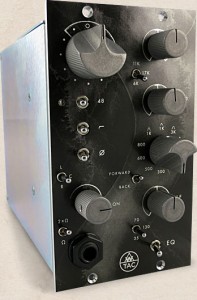Made in NY: Awesome Channel Amplifier
Is it possible to fit an entire vintage console into a single box roughly 5” wide and 6” high? Recording engineer and gear designer Dave Raphael is determined to try just that. His audaciously-named “Awesome Transistor Amplifier Company” (AwTAC) has released a new 500-series rack unit, and they are building them here in New York City.
At first glance, The Awesome Channel Amplifier appears to be a simple double-wide mic pre and EQ made to fit into a standard API-style studio lunchbox. But the underlying design philosophy suggests that the Awesome Channel is meant to be much more than that.
Several years ago, when boutique mic preamps took the audio world by storm, becoming hot-selling items thanks in large part to the power of history, prestige and great marketing, some recordists found themselves scratching their heads. They expected that for all the talk, these mojo boxes might have left more of an imprint on their sound.
But, “If you dig the sound of old 1970’s records,”Raphael explains, “you are listening to the sound of an entire console.A discrete preamplifier design is just one element.”
He likens a preamp detached from a console’s signal path to a “ladder from a fire truck.” “Useful, but if you want to drive around and put out fires, you gotta have the whole affair.”
The way Raphael sees it, the “whole affair” goes something like this:
“Input transformer-> mic amplifier stage(s) -> output transformer-> EQ amplifier stages -> output transformer-> routing/panner module amplifier stages-> buss amplifiers (in either active of passive bussing schemes)-> input transformer (for passive busses) -> make up / pre fader amplifiers -> line driving amplifier-> output transformer.”
In order to achieve the sound – and the signal path – that he envisioned, there are many more amps and caps and buffers stuffed into the Awesome Channel design than some modern electrical engineers might recommend. But for Raphael, that’s the whole point.
To him, each stage of a complete console circuit provides an opportunity to add weight, power and character to the sound, or, depending on your perspective, to pleasingly degrade it.
“I never bought into that notion that an amplifier can – or even should – be a ‘straight wire with gain,’” he says. “An amplifier is always going to do something.”
And if that’s going to be the case, then Raphael wants to make sure that “something” sounds as big and as interesting as possible.
Where some engineers advocate for recording chains that add the least color possible, Raphael’s goal is to make sure whatever color does exist sounds good to his ear. To this end, he’s spent countless hours A/Bing capacitors and other small components, tweaking each stop along the Awesome Channel Amplifier by ear as well as by the numbers.
Although he’s a fan of British designs from the 1970s, Raphael says that he was not looking to emulate any specific vintage console. Rather, he followed his tastes and collaborated with Jens Jungkurth of Eisen Audio and Exile Recording to build a box that would deliver the distinctive sound he had been chasing while using modern components.
“It’s a really chilled-out sounding amp,” he says. “It’s not very aggressive – It’s really wide and really big without losing its authority.”
The Awesome Channel also includes an EQ that is meant to sound smooth and musical even in its most extreme settings. And beyond sound quality, the units were designed to stack together, using XLR cables to form a 500-series-based multi-channel mixer, complete with LR bus assigns. This makes the ACA one of the few boutique preamps we know of that will allow you to combine the output of multiple microphones down to a single mono or stereo track.
But the design and manufacture is also about more than Dave Raphael’s mission to put console character and functionality back into the modern rack-based recording chain. “We wanted to make this as much an American product as can be sensibly done in 2012,” he says.
The front panels were milled in California and printed in Pittsburgh, and the knobs were made in Ohio. Units themselves were assembled between Coral Sound in Long Island City (in the building where Andrew Roberts once built his groundbreaking Purple Audio line) and in Jens Jungkurth’s small personal shop in Brooklyn.
Building and sourcing these units in the U.S. was a matter of principle according to Raphael, even when some aspects of that were difficult
“If I was comfortable sending this overseas I could have gotten it done at a fraction of the cost and at a fraction of the speed,” he says. “It was a challenge at first, just finding people in America who were willing to do some of these jobs – at any price.”
But despite a few brief crises of faith, Dave Raphael was eventually able to source all the major work here, and still offer the Awesome Channel at a price that is competitive with other boutique designs.
At $1,600, this mic-pre/EQ/mini-console-channel is in the same ballpark as other units that may offer less color.
While AwTAC’s introductory special lasts, if you buy “Awesome Channels”, you’ll get the NY-designed Purple Audio Sweet Ten rack for half price. If you buy four in order to create a rack-based mini-mixer of your own, then the Purple Audio Sweet Ten, normally $800, comes free.









Jens Jungkurth
September 21, 2012 at 6:48 pm (12 years ago)Indeed, the crew proudly assembling AwTAC units here at Eisen Audio is comprised solely of native Brooklynites. It doesn’t get much more Made in NY.
Meanwhile, Exile Recording is the product of Matt Marinelli & Co. (Coral Sound) and all their hard work and passion. As much as I enjoy the association, I can’t take credit for that awesome studio.
Thanks, Justin!
Daniel
September 28, 2012 at 3:34 am (12 years ago)Went to the site, but couldn’t find any sound samples.